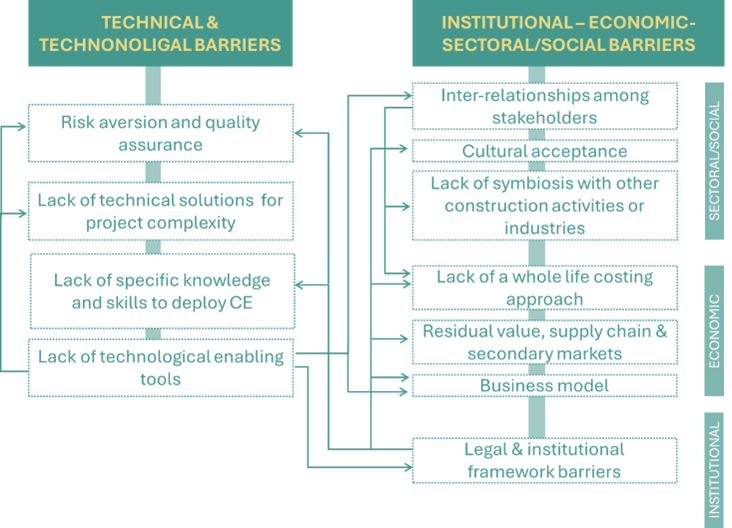The Challenge of Circular Economy in the Built Environment
The Circular Economy (CE) is an alternative approach to how we manage resources. Instead of the traditional “take-make-dispose” method of the linear economy, CE is about designing products and systems where materials are reused, repaired, and recycled continuously1. This approach not only minimizes waste but also reduces the need for extracting new raw materials, which helps lower emissions and fight climate change. Even though its benefits are widely acknowledged, the actual application of circular economy principles has been slow, especially in industries like construction, as construction and demolition create over 40% of the EU’s total waste2. The Intergovernmental Panel on Climate Change (IPCC, 2022)3 has highlighted that while the idea holds enormous promise in theory, there remains a significant gap when it comes to putting these principles into practice.
The built environment presents unique obstacles due to its highly fragmented value chain, with numerous stakeholders operating at different stages of a project’s life cycle both up-stream and down-stream. This fragmentation complicates collaboration, a fundamental requirement for effective CE integration. Unlike other sectors, the construction industry predominantly follows a linear economic model driven by financial profit, which often discourages sustainable practices.

Figure 1: Singularities of the Infrastructure sector, adapted from Coenen, Visscher and Volker, 2023 4
Within the construction sector, transport infrastructure stands out due to its distinct characteristics, which further shape its interaction with CE principles. These characteristics include:
- Long life cycles and durability requirements: Infrastructure projects are designed to last decades, making adaptability to new circular practices more complex.
- High levels of public funding and regulation: Unlike private developments, infrastructure projects are typically financed and governed by public institutions, making policy and regulatory frameworks crucial to driving change.
- Conservative risk management and technical standards: Given the high costs and safety implications, infrastructure projects prioritize stability over innovation, creating barriers to adopting new materials and circular design principles.
Identifying Barriers: Insights from Literature
As part of the CIRCUIT project, partners carried out a comprehensive analysis to identify and categorize the barriers preventing CE implementation in transport infrastructure. To do so, the first step was conducting a Literature Review: Analyzing scientific articles, industry reports, standards, and white papers to establish a rigorous analytical framework for understanding CE barriers, drivers, and enablers.
This literature review confirmed that while technical feasibility is necessary for CE implementation, the most significant barriers are not technical but economic, social, and institutional. Public funding models, risk-averse procurement policies, and the financial structure of infrastructure projects significantly impact the feasibility of circular solutions.

Figure 2: Classification and relationship between barriers to the implementation of Circular Economy.
Key Barriers to Circular Economy Implementation
From the literature review, over 50 specific barriers were identified and categorized, highlighting their interrelated nature. These barriers can be grouped into four primary categories:
- Economic Barriers
Economic factors are among the most cited obstacles in CE adoption, often described as “hard” barriers. These include:
- High upfront costs: Circular solutions often require significant initial investments, such as advanced recycling technologies, new construction techniques, and circular business models, which may not yield immediate financial returns.
- Lack of a clear business case: Many stakeholders struggle to see the long-term financial benefits of CE due to unclear cost-benefit analyses and limited real-world examples of successful circular infrastructure projects.
- Market challenges: The lack of a developed secondary materials market makes it difficult to ensure the availability and quality of recycled materials at competitive prices.
- Inadequate financial instruments: Limited incentives, such as tax reductions, subsidies, or green finance options, reduce the attractiveness of circular investments.
2. Regulatory and Institutional Barriers
Regulations play a decisive role in shaping infrastructure projects. However, current policies often discourage circularity due to:
- Rigid and outdated regulatory frameworks: Many construction standards and technical specifications are designed for traditional materials and processes, making it difficult to introduce secondary materials or innovative circular practices.
- Risk-averse public procurement processes: Infrastructure contracts prioritize reliability and cost-effectiveness, often penalizing innovative circular solutions that may carry perceived risks.
- Lack of institutional incentives: Without strong policy drivers, such as mandatory circularity requirements or extended producer responsibility schemes, companies have little motivation to transition.
3. Social and Cultural Barriers
Cultural resistance within the construction and infrastructure sector also hinders CE implementation:
- Conservatism and resistance to change: Infrastructure professionals and decision-makers tend to favor traditional methods over experimental approaches, particularly in safety-critical projects.
- Lack of collaboration across the value chain: CE requires seamless cooperation between designers, contractors, material suppliers, and policymakers—something that remains difficult due to siloed working methods.
- Limited awareness and expertise: Many industry professionals are unfamiliar with CE principles and lack the necessary skills to integrate them into infrastructure projects.
4. Technical and Technological Barriers
While less dominant than economic and regulatory issues, technical challenges remain relevant:
- Lack of quality assurance for secondary materials: Ensuring the durability, strength, and consistency of recycled or repurposed materials is a significant concern.
- Compatibility issues: Many circular materials and design principles are not yet fully compatible with existing infrastructure specifications.
- Limited technological readiness: While innovative CE technologies exist, they are not yet widely adopted or scaled within the infrastructure sector.

Figure 3: Main barriers to the implementation of Circular Economy according to the literature review.
Toward a More Circular Future
As this analysis shows, shifting to a circular model in transport infrastructure is not just about new materials or technologies. It’s a systemic challenge that requires changes in procurement, regulation, funding, and professional culture. The barriers are not isolated. They form a web of interdependencies that must be tackled in parallel through policy reform, training, and market stimulation. Overcoming these challenges will demand coordinated action between public authorities, contractors, industry associations, and material producers. Only then can the promise of circularity move from pilot projects to mainstream practice.
References
1 Ellen MacArthur Foundation: https://www.ellenmacarthurfoundation.org
2 AlJaber, A., Martinez-Vazquez, P. and Baniotopoulos, C. (2023) ‘Barriers and Enablers to the Adoption of Circular Economy Concept in the Building Sector: A Systematic Literature Review’, Buildings. Multidisciplinary Digital Publishing Institute (MDPI). Available at: https://doi.org/10.3390/buildings13112778.
3 IPCC, 2022: Climate Change 2022: Impacts, Adaptation, and Vulnerability. Contribution of Working Group II to the Sixth Assessment Report of the Intergovernmental Panel on Climate Change [H.-O. Pörtner, D.C. Roberts, M. Tignor, E.S. Poloczanska, K. Mintenbeck, A. Alegría, M. Craig, S. Langsdorf, S. Löschke, V. Möller, A. Okem, B. Rama (eds.)]. Cambridge University Press. Cambridge University Press, Cambridge, UK and New York, NY, USA, 3056 pp., doi:10.1017/9781009325844.
4 Coenen, T. B., Visscher, K., & Volker, L. (2023). A systemic perspective on transition barriers to a circular infrastructure sector. Construction management and economics, 41(1), 22-43.
👉🏽 For further insights and detailed references of the literature analysis, CIRCUIT’s Deliverable D1.2 “Upstream and Downstream Supply Chain Actors’ Needs” examines the key challenges and expectations of stakeholders in the transport infrastructure sector. While this document is not yet publicly available, it will be released as soon as possible.


